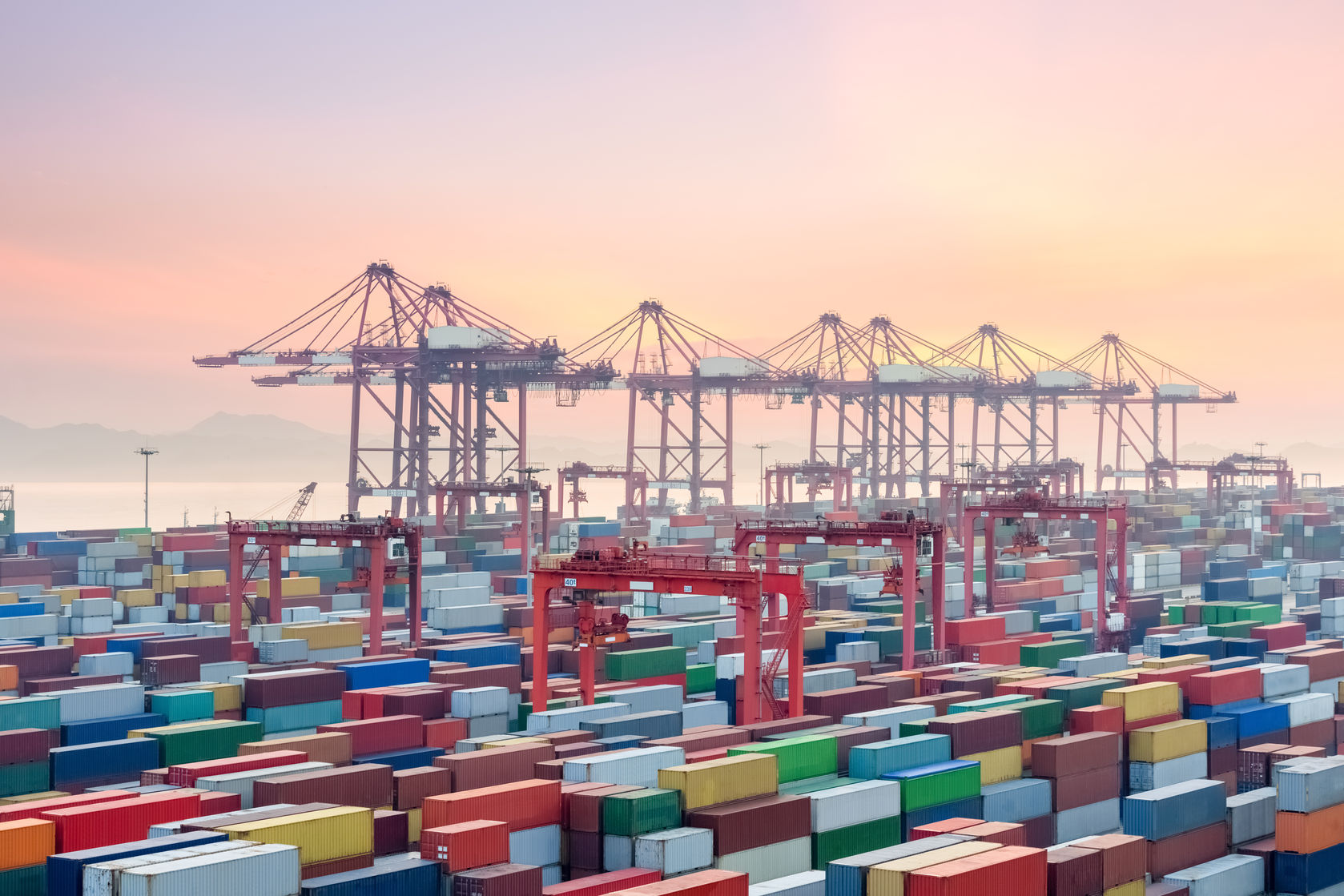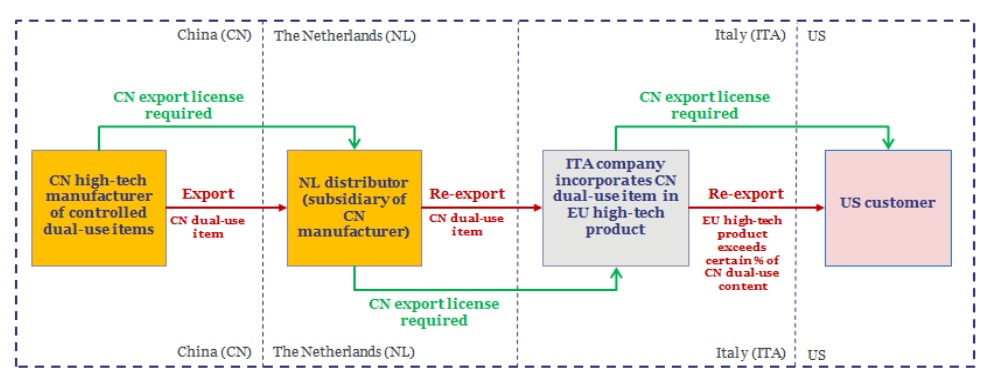19 July, 2018
Companies having China-related operating activities should watch out for and anticipate on the upcoming transformation of China's export control framework and system. China's released draft Export Control Law ("ECL")1, currently pending introduction at the National People’s Congress, may affect major MNEs and SMEs operating in- and outside China which are engaged in the manufacture, development, use and/or supply of China- related products (including components) and technologies – especially – in the high-tech sector.
It is no secret that China, driven by its "Made in China 2025" initiative, is focusing on achieving mastery in the production and self-sufficiency of certain key technologies in key industries and sectors (such as aerospace, telecoms, power production and distribution, new IT and integrated circuits, etc.). In essence, China is aiming to become a world-leading tech quality manufacturing power.
You may wonder how? Well, China is among others heavily investing in promoting and upgrading its domestic innovative manufacturing technologies and capabilities (so-called "smart manufacturing") which should ultimately enhance the global high-tech competitiveness of Chinese enterprises. Achieving smart manufacturing as well as self-sufficiency in the relevant key industries will simultaneously increase the export of high-end manufactured items having their origin in China to the rest of the world. As a consequence, China will become far less dependent on imports of high-end technology solutions, products and equipment from foreign and overseas (high-tech) companies.
Considering this shift of focus from import of foreign – to – export of its own cutting-edge technology items, it is no surprise that China is also looking to improve its export control regulations, decision-making processes and practices based on the released draft ECL.2 The latter,
if adopted in its current form, will gain increasing importance – especially in relation to cross- border transfers of Chinese high-tech items and technologies – as Chinese businesses are to evolve into major manufacturers and exporters of key technologies in key industries following the "Made in China 2025" initiative.
1. What are export controls?
Export controls stem from multilateral export control regimes which were established by several countries in a mutual effort to stem the proliferation of nuclear, chemical and biological weapons and missiles capable of delivering weapons of mass destruction ("WMD").
These non-proliferation international export control regimes which include the Australia Group (AG), the Zangger Committee, the Missile Technology Control Regime (MTCR), the Nuclear Suppliers Group (NSG) and the Wassenaar Arrangement on Export Controls for Conventional Arms and Dual-Use Technologies (WA), regulate and control among others the supply, transfer and export of conventional arms and so-called "dual-use" items and related technologies. Dual-use items are tangible (e.g. raw materials, components, complete systems, etc.) and intangible goods (e.g. software, technical data, etc.) which have the potential to be used for both military and civilian purposes. The general rule is that the export of such conventional arms and dual-use items is prohibited unless prior to the exportation formal authorisation has been granted and obtained from the competent export control authority.
Many governments (such as Australia, Canada, EU Member States, United States, Japan, etc.) have joined as participants to the aforementioned international export control regimes in order to collectively pursue their implementation and available tools and controls into their national laws and, as such, create and define their own export control framework, license systems and policies.
2. How come China is reforming its export control framework?
China joined as a participant to a single international export control regime, namely the NSG. The current general perception is that China's legal framework for export controls is rather at an early stage of development due to its short existence span (originating from 1990's) compared to the export control frameworks and policies of participants having a long-standing membership in all international export control regimes (such as the EU Member States and the United States).
The latter perception is about to change as China is planning to modernise and upgrade its existing export control legal framework and system which are currently made up of various laws, decrees and regulations as well as complex decision-making structures and processes.
Following the release of the draft ECL in June 2017, China is keen to put into place and implement a comprehensive export control framework and system whereby China's and ECL's main objective is to effectively safeguard and maintain China's national security as well as protect industrial and economic development and related benefits.
Second, China's existing export control framework and system was set-up a long time ago lacking proper legal authority, hierarchy and investigative powers in view of performing adequate controls and enforcement actions in practice.
And third, the draft ECL is to further guarantee fulfilment of China's international commitments and obligations as well as – through its promotion and implementation – strengthen international cooperation.
3. What aspects of the current draft ECL should you watch out for?
Several export control elements of the current draft ECL may affect businesses in practice, such as:
[New] comprehensive list of controlled items:
the following items – as defined in the current draft ECL – are to comprise China's export control list and, hence, be subject to the export control provisions and licensing requirements of the ECL:
i) dual-use items;
ii) military items;
iii) nuclear items; and
iv) other items.
In relation to sub iv), other items – not being listed on China's export control list – may be subject to controls and licensing in certain situations (where this may endanger China's national security or in relation to proliferation or terrorism risks). Furthermore, we note that the actual list of controlled items has not been made public (yet).
[NEW] consideration of competitiveness of trade and industry controls:
in view of compiling and amending its export control list, besides its national security and international obligations, China will also take into consideration:
i) trade and industrial competitiveness,
ii) international market supply; and
iii) technology development.
The factors i) to iii) are also be taken into account in view of submitted export control licensing applications as well as the issue of export control licences in China;
[NEW] possibility to impose an embargo:
China may impose an embargo by prohibiting the export of certain controlled items or prohibiting them from reaching specific destinations to specific individuals, entities or organizations.
[NEW] re-export controls:
businesses located outside China will be subject to China's extraterritorial export control licensing provisions and controls in relation to
i) the re-export of Chinese controlled items when located outside China; and
ii) ii) re-export of foreign-made items that contain Chinese controlled items where latter value exceeds certain percentage threshold. Please see below illustrated example scenario;
Please click on the image below to enlarge.
[NEW] deemed export controls:
this concept involves licensing controls in relation to the supply of controlled items (e.g. controlled commodities, technologies and services) by Chinese nationals and legal entities to foreign citizens (i.e. individuals that do not have Chinese nationality) and legal entities, as illustrated in below example scenario:
Please click on the image below to enlarge.
[NEW] possibility for blacklisting
China will establish so-called black lists stating foreign importers and end-users that have violated the ECL and may endanger national security and development interests of China. In addition, China's domestic importers can be subjected to control measures prohibiting the export of controlled items to such blacklisted individuals and entities;
[NEW] equal principle:
where China takes the view that a third country has adopted discriminatory export control measures against China, China may take corresponding measures against the relevant country;
[NEW] emergency controls:
in wartime or other emergency situations in international relations, China may take necessary control measures for the export of any goods, technologies and services in order to safeguard its security national security.
Overall, the current version and content of the draft ECL demonstrates China's desire to overhaul and tighten its export control framework and system in view of effectively protecting its national security as well as economic (and technological) development (considering its goals under the "Made in China 2025" initiative).
4. Who is to comply?
As depicted above, the draft ECL has an extraterritorial character having authority and effect and beyond the normal territorial boundaries of China. The ECL applies and impacts any individual or business in- or outside China dealing with Chinese controlled items.3
If the current version of the ECL is adopted, the ECL will apply also to agencies, freight forwarders, customs brokers, third-party electronic trading platform (e-commerce) providers and financial service providers.
5. What are the penalties?
Any violations of the ECL could result in a warning or a penalty up to 10 times the illegal business revenue. Usually a fine up to RMB 500,000 could be imposed if the illegal business revenue is less than RMB 50,000. In addition, any illegal income would be confiscated.
Several non-financial penalties can also be imposed on businesses, including suspension or revocation of export licenses as well as being blacklisted in China’s social credit system.
For individuals, the personal liability for those directly responsible for breaching the ECL could include fines up to RMB 300,000.
And last but not least, criminal charges may also be brought in case of any serious violations.
6. Will the ECL impact business in- and outside China?
If the current version of the ECL is adopted, the earlier stipulated export control elements having extraterritorial reach will have significant impact for businesses – active in China as well as outside China – dealing with Chinese controlled items. The importance and impact of the ECL will also increase as the goals of the "Made in China 2025" initiative come within reach for China.
Moreover, in the light of the recent trade discussions and measures between the United States and China, ECL's incorporated elements dealing with "competitiveness of trade and industry", "international market supply" and "equal principle"– which are open for interpretation – could also add additional layers to uncertainty in the international trade arena of controlled items.
In summary, businesses should gain awareness and understand the potential changes the draft ECL (if adopted in its current form) is to bring along to their operations in view of being adequately and timely prepared to i) ensure compliance with the China's upcoming new export control framework and ii) secure continuance of their business operations and activities in China as well as outside China.
1 See http://tfs.mofcom.gov.cn/article/as/201706/20170602594467.shtml.
2 Since the 1990s, China has successively formulated administrative regulations and the export control legal system such as the "Regulations on the Control of Nuclear Exports", "Regulations on the Control of Exports of Nuclear and Dual-Use Materials, and Related Technologies" and initially established dual-use controls covering military products, nuclear, biological, chemical items as well as related guidance. In order to better promote and guarantee export controls, safeguard the interests of national security and development, and fulfil international obligations, China believes that is now necessary to formulate a single basic law in the field of export controls and to guide existing administrative regulations and rules.
3 On a comparative note, the case of Chinese company ZTE shows the possible consequences (high fines and export ban) of non- compliance with extraterritorial re-export controls following United States export control legislation. See for example: [http://www.scmp.com/business/companies/article/2142062/timeline-how-did-chinas-largest-listed-5g-phone-equipment-maker] last accessed: 5 May 2018.

.jpg)







